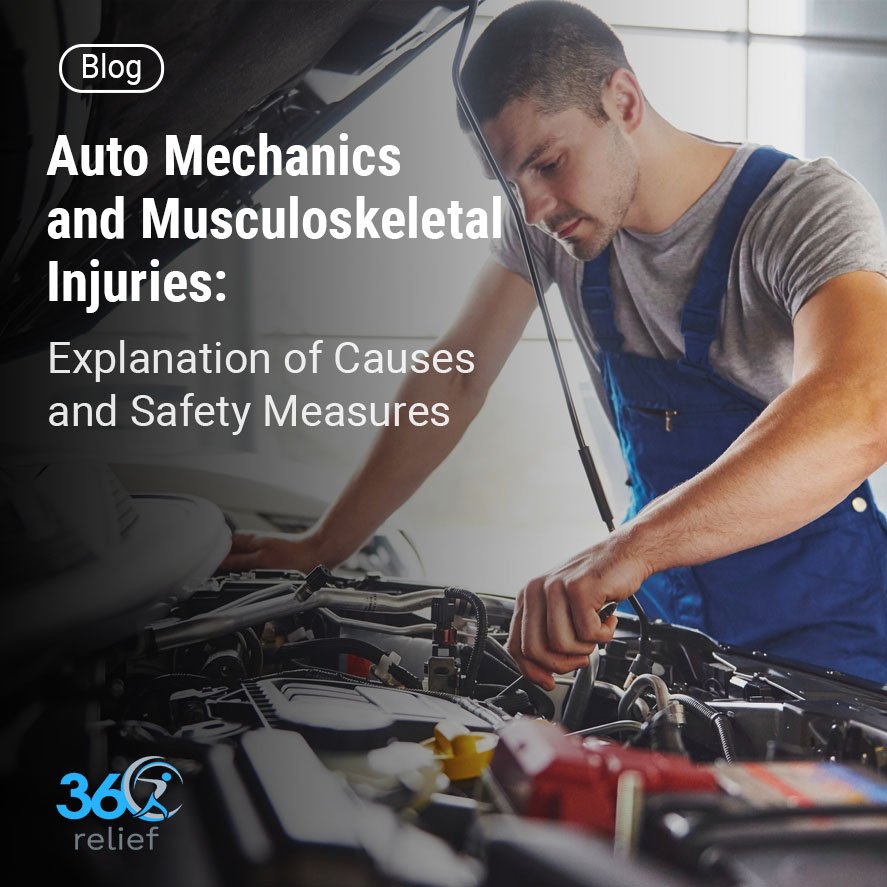
Make This Christmas Pain-Free: 10% Off on Supportive Wear!
Holidays are coming, which means that let’s welcome them with joy, laughter, and, of course, some comfort! At 360 Relief,

Auto mechanics are skilled technicians who work tirelessly to keep our automobiles running smoothly. Auto mechanic work has some hidden concerns that frequently go unnoticed. The concerns that must not be forgotten are the musculoskeletal injuries. Yes! Auto mechanics face a number of challenges while performing their duties. These challenges may have profound effects on their physical well-being.
It has been found that auto mechanics are at an elevated risk of developing musculoskeletal injuries while performing several tasks, including wrenching the nuts and contorting the vehicle bodies into tight spaces. Here come several questions, including what are the main causes behind these injuries and are there any safety measures that can be implemented to protect automobile mechanics while performing their jobs?
This article is a detailed account of the common causes leading to serious injuries related to muscles and joints in automobile mechanics or workers. As well as this, we have also discussed the best safety measures, suggested by professionals, to help workers get a safe and injury-free job experience. So, let’s begin our discussion here to teach automobile mechanics to know the causes of injuries and the possible safety measures to avoid the risks of injuries:
Table of Contents
ToggleFrom repetitive motions to lifting heavy tools, and staying in awkward positions, automobile mechanics are at a high risk of injuries. Here we come with the commonly found injuries along with their causes. It will help workers or technicians to pay proper attention while working to tackle all the challenges they can face during their jobs:
Automobile mechanics are required to continuously use power tools and hand tools that may be subject to vibrations and awkward position of the wrist. Over time, these factors may contribute to serious ailments and carpal tunnel syndrome is one such example. Carpal tunnel syndrome usually results when the median nerve is pressed due to excessive pressure or awkward positions. The common symptoms associated with carpal tunnel syndrome may include pain, tingling sensation, numbness, and weakness around the hand or wrist joint.
The basic preventive measure is to use ergonomic hand tools. Wearing anti-vibration gloves helps minimise exposure to vibrations. Healthcare professionals also suggest wearing wrist support braces to keep the wrist joint aligned, helping reduce excessive pressure on the carpal tunnel. Thus, it helps reduce the risks of carpal tunnel syndrome.
Where auto mechanics are susceptible to wrist pain, at the same time, they may be vulnerable to arm pain or injury. Arm pain usually results from using vibrating tools. For example, the excessive use of wrenching and grinders may expose automobile mechanics to hand and arm vibration, which may result in hand-arm vibration syndrome. The condition may result in circulation problems, pain, and numbness in the hand and arm.
The basic safety measure is to use ergonomic tools to reduce the impact of vibrations or overuse. If you feel yourself susceptible to injury, you should wear anti-vibration gloves and arm support braces to avoid musculoskeletal injuries during your job.
Auto mechanics are required to twist, bend, and lift heavy objects or automobile parts and tools during their job. These actions can place immense strain or stress on the lower back. Along with these repetitive actions, inadequate lifting techniques and poor posture can lead overuse of ligaments and muscles. Thus, the overall conditions may result in lower back pain and injuries.
Maintaining a good posture is necessary to reduce the chances of lower back strains. As well as this, learning proper lifting techniques is also essential. You must use lifting equipment or aids when necessary. Wearing lower back support braces helps keep the spine aligned and reduces the impacts of overusing your lower back.
Automobile mechanics are also in need of, lifting, reaching, and working in confined spaces, causing strain to the shoulder muscles and tendons of rotator cuff. Besides this, improper body mechanics and overextension during repetitive tasks may cause the rotator cuff to be inflamed and torn. The condition results in pain and limited range of motion.
Promoting ergonomic workstations is the basic safety measure to reduce injuries, including rotator cuff tear. Taking regular breaks and performing stretching exercises on the shoulders are also necessary. Wearing shoulder support braces helps avoid overextensions, reducing the chances of rotator cuff tears. Workshops must also educate mechanics on the proper lifting techniques.
As automobile mechanics are required to lift heavy weights in the form of automobile parts and tools, they may be at an increasing risk of herniated discs. The common causes of herniated discs may include improper lifting techniques or additional force or pressure on the spine. The condition leads to pain, numbness, and weakness around the spine or back.
Educating your workers or automobile mechanics in proper lifting techniques is the basic safety measure for preventing the chances of herniated discs. Having mechanical aids, such as jacks and hoists for lifting heavy weights or objects is crucial. Healthcare advisors also suggest wearing back support braces to reduce the impact of putting excessive pressure on the spine.
Several tasks require prolonged kneeling and squatting while working on vehicles. This continuous kneeling or squatting and repetitive bending may put excessive pressure on the knee joints, causing knee injuries, such as patellar tendinitis. The common symptoms associated with patellar tendinitis and other severe knee conditions may include pain, swelling, tenderness, and weakness around the knee joint.
If you are required to kneel or squat for a prolonged time during your duties, try to use cushion mats and knee pads. It is also advised to elevate the workplace, minimising the need of kneeling or squatting. When needed, wear knee support braces to provide needed support and compression to your knee joints. Taking regular breaks is also helpful to avoid the chances of overuse knee injuries.
The duty of repairing and maintaining vehicles or automobiles is among the hard duties that come with the chances of musculoskeletal injuries. The common injuries found in automobile mechanics are explained here along with their causes and symptoms. Understanding these causes and symptoms can help you avoid the chances of injuries. As well as this, the discussed safety measures are surely helpful in performing your duty safely without facing any injury. Keep in mind all these safety measures to have a wonderful working journey.

Holidays are coming, which means that let’s welcome them with joy, laughter, and, of course, some comfort! At 360 Relief,

Happy Cyber Monday to everyone; it is a perfect occasion for 360 Relief to offer a special discount of 10%

This Black Friday, take advantage of exclusive 10% savings on some of 360 Relief’s best-selling compression socks and support braces!

Everyday life includes walking up stairs, but knee discomfort can make this basic activity difficult. Walking up or down stairs

Cooking is a beloved activity for many, but for those struggling with knee pain, standing in the kitchen can quickly

We’ve all been there. On a ride in a car, for instance, to the country home for a weekend break

Gardening is enjoyable for many people and those who like tending to their lawns and plants usually find it therapeutic

Do you have a painful knee problem that takes you to physiotherapy…for an injury that hampers your daily living…your workout

Training can be very much associated with some pains and injuries that may be experienced by the trainers. As there

Office workers often spend hours seated at their desks, focusing on tasks while unknowingly putting their health at risk. The

Winter often brings more than just a change in weather; for many, it also means dealing with unexpected swelling in

Compression socks have become a critical tool for athletes across all sports. Whether you’re a marathon runner, cyclist, or weightlifter,

October marks the beginning of National Cholesterol Month in the UK, a time dedicated to raising awareness about cholesterol and

Overall, there is nothing to match the experience of watching musicians perform live in an outdoor concert in Glastonbury. However,

Today charity runs have gained popularity as a way of raising cash for a cause in the United Kingdom. From
Please enter your email to subscribe to our newsletter for exclusive offers and updates
Copyright © 2025 | 360 Relief Ltd | Sitemap

